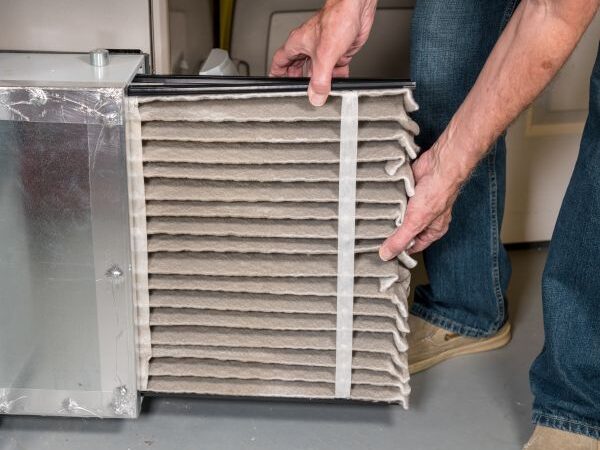Each year, homeowners collectively waste millions of dollars on excessive energy costs resulting from not effectively winterizing their homes. Still others choose to endure the coldest days of the year shivering under a pile of blankets, deliberately choosing not to use their HVAC systems at maximum capacity in the hopes of avoiding a hefty heating bill.
Both of these problems can be greatly reduced by taking a few easy steps to winterize home structures and appliances. In the following blog post, we’ll discuss the steps homeowners should take to save energy and reduce utility bills during the colder months of the year so they can enjoy a cozy and comfortable winter without breaking the bank.
Start By Sealing Drafts
Areas in the home that have not been properly sealed, including gaps, cracks, and other small openings, can allow heat to escape and cold air to sneak in. When these drafts occur, it forces your HVAC system to work significantly harder, as it will struggle to keep up with the constant influx of colder air. As a result, your fuel costs will increase, and there may still be parts of the home that never become sufficiently warm.
The majority of drafts in a house come from gaps near openings such as windows and doors. To check for air leaks in your house, you can begin by inspecting these areas. An effective method of pinpointing leaks in the caulking or sealant around doors and windows is to use the candle test: Carefully move a lit candle around the door or window, and watch closely what the smoke does. If it is pulled toward the window or door or pushed away, this could be a telltale sign of a temperature change caused by a leak. For an even more accurate reading, a digital leak detector can also be purchased online or from a hardware store.
Once you have pinpointed any drafty areas in your home, you can begin the process of sealing them. Depending on the size of the opening, you may be able to do this with a piece of weatherstripping or windproof tape; larger holes may require an application of caulking or a repair from a contractor.
Ideally, this should be done before the winter weather becomes too cold. The stress placed on compromised areas by ice, snow, and extreme temperatures can further compromise them. In addition, caulking materials and the adhesive on weatherstripping may not work properly at temperatures below 40 degrees. The process of winterization means being diligent throughout the year.
Invest in Insulation
Heat energy can also be lost as a result of inadequate insulation. In a well-insulated house, the HVAC system is better able to maintain a consistent and comfortable temperature with minimal energy loss. Unfortunately, many homes are not effectively insulated, and heat escapes outside, leading to increased energy bills and less comfortable rooms. Since insulation materials degrade over time, even well-insulated buildings will become less so if maintenance is neglected.
To improve the quality of insulation in your home, there are several steps you can take. Since warm air rises, most homes lose a lot of heat through their roofs. As such, poorly insulated attics are the direct cause of a lot of inflated energy bills. Adding insulation to the attic can therefore be one of the best steps a homeowner can take toward winterization and reducing heating costs.
There are several methods for improving the insulation in the attic and other areas. While it’s possible to DIY this type of work, it’s usually a better idea to hire a professional contractor to bring specialized equipment to ensure no areas are missed. Modern methods, such as spray-on insulation, are extremely effective at sealing small gaps and cracks and ensuring that even awkward corners and hidden areas are well-protected from heat loss.
Maintain Your Furnace
Winterizing home appliances is another key step toward thriving in the colder months. Particularly, you need to take care of your furnace. Regular maintenance is a must. Winterizing your furnace means ensuring it operates at peak efficiency during the time of year when it is expected to work hardest. Failure to do so will not only reduce the energy efficiency of your furnace, but it also can potentially lead to more serious issues as the system falls into disrepair, sometimes even causing it to fail to operate entirely.
Since your furnace will see heavy use during the winter months, it’s important to have the necessary maintenance and repairs performed well in advance, during the time of year when the furnace sees less use. Fall or spring is ideal for this, since not only is the climate more temperate during those times of year, but HVAC maintenance can often be completed more quickly due to the decreased demand for HVAC services.
To ensure effective operation during the winter months, homeowners should schedule an appointment with an HVAC contractor for a system inspection and basic repairs and maintenance at least once a year. Your HVAC contractor will work their way down a checklist, performing essential tasks, such as cleaning or replacing filters, inspecting pilot lights, and testing electrical connections (including the thermostat) to ensure everything is working properly. They may also make recommendations for necessary repairs so that you can catch and repair problems before they develop into more serious (and more expensive) issues.
Who to Call for HVAC Repairs and Replacements
While you can do a lot to winterize your home on your own, when it comes to preparing your HVAC system, you’re going to need the assistance of a trained HVAC professional. It’s important to have a trusted company to call on for both basic maintenance and emergency repairs. The technicians who work on your furnace should be highly experienced, specially trained, and certified by reputable organizations, such as NATE. They should also work for a company that is properly insured and with a reputation for excellence in serving their local community.
The professionals at All Weather Heating & Cooling meet all of these requirements and more, having proudly installed and serviced HVAC systems for over 25 years. Contact us today, and we’ll help you ensure your home is ready for this winter.

